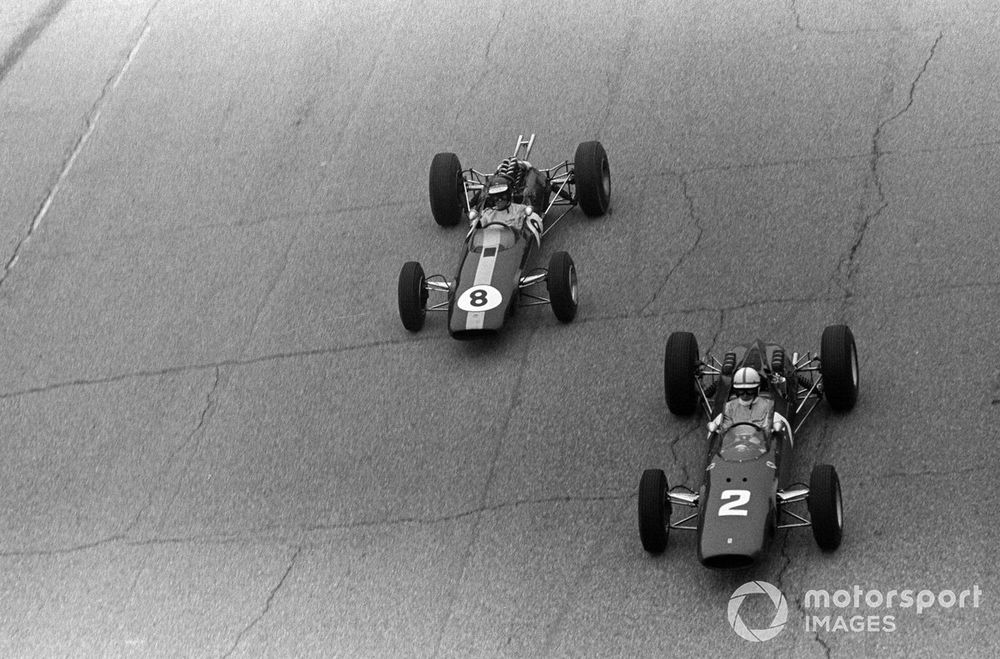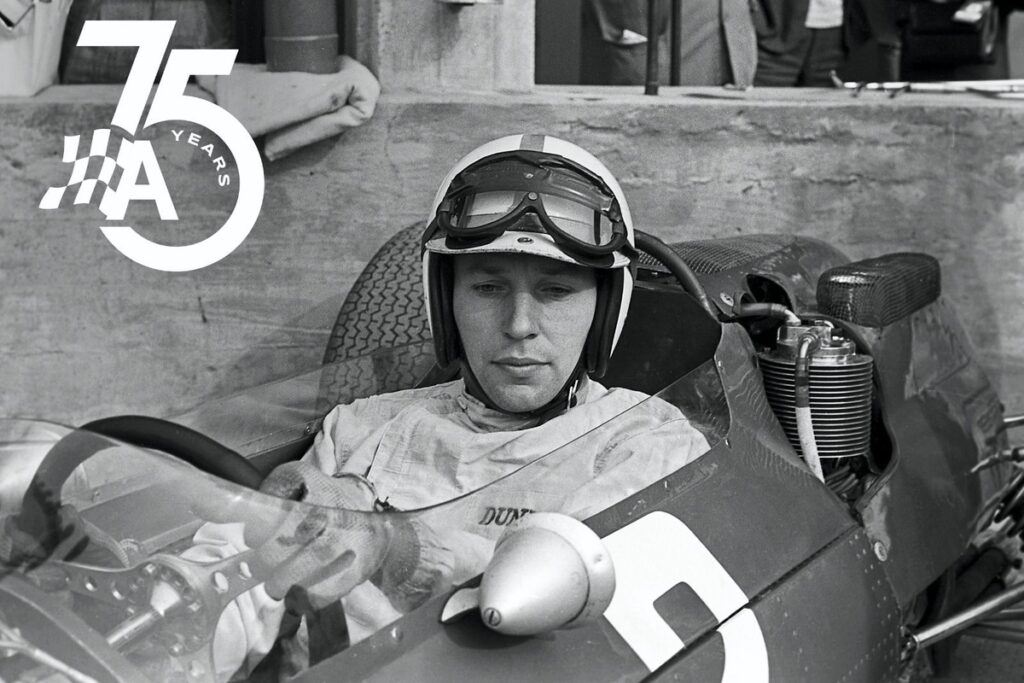The failure of Jim Clark’s Lotus with just over a lap of the Mexican Grand Prix to go, which robbed the Scot of a second consecutive Formula 1 title, could be seen as the defining moment of 1964. That, or the clash in the same race between championship contender Graham Hill and the second Ferrari of Lorenzo Bandini. But both sell John Surtees’s world crown far too short.
Having moved to a beleaguered Ferrari – this was shortly after a team split and dire title defence in 1962 – Surtees had work to do. Not only did he help raise the Scuderia’s game, but he also had to dig deep to recover from a poor start to the 1964 campaign.
Unlike Clark, Surtees’s hard luck came at the beginning of the year. In the first four rounds, the Englishman’s Mauro Forghieri-penned Ferrari 158 finished only once.
“The 158 suffered from being a bit late and not having quite as much dedication into the package as we would have liked, if Ferrari had been totally focused on F1,” says Surtees. “Unfortunately, the first focus was on testing cars for the prototype series – the Monza 1000Km and Nurburgring. I had great enjoyment driving those super cars, but it was tinged by the fact we were neglecting the F1 programme.”
The semi-monocoque 158 was not a bad chassis, but engine performance – supposedly one of Ferrari’s fortes – was a key issue. Not only did the team run or develop six-, eight- and 12-cylinder engines during the season, it also had trouble with direct fuel injection.
Surtees: “Whereas the six-cylinder tubular car [of 1963] was a little more like the Cooper to drive – driveable but consuming a bit of power when travelling sideways – the eight-cylinder became a good-handling car, certainly more economical with its power. Not to the degree a Lotus was, but certainly an improvement.
“The Climax engine [as used by Brabham and Lotus] had a very good mid-range. This was one of the things that Ferrari had to come to terms with – Climax tended to produce a more useable power range. The Italian-type engines tended to be a little bit top-endy.
Surtees endured an underwhelming start to the season with one finish in the opening four rounds
Photo by: Motorsport Images
“Ferrari tried to do a bit of a catch-up by thinking that direct injection, working with Michael May and using developments of the systems that had been used by Mercedes-Benz cars, was the way to go. Making that work on the smaller-capacity [1500cc] engines brought a number of teething problems and early-season retirements.”
Gearbox trouble was the main problem at the season-opening Monaco GP, which Hill won. Surtees took second at the Dutch GP, but engine issues prevented a possible win in the Belgian GP, where Clark took a rare lucky victory when three cars failed ahead of him on the final lap.
When Clark narrowly beat the consistent Hill in the British GP – Surtees was third – it looked like a two-horse race for the title. At that halfway mark, Surtees had just 10 points to Clark’s 30 and the 26 of Hill.
But then two things happened: Ferrari hit form and bad luck befell the two championship leaders.
“The saddest thing, in some ways, was in Austria when the car broke when I was leading the race. The circuit was very rough, but one thing I didn’t expect was for the Ferrari to break its suspension” John Surtees
“It wasn’t until Le Mans [in June] was over that we went to Bosch and did some more testing, and that we got the better regulation introduced to the injection system,” adds Surtees. “We got it working just before the German GP. That made the car more driveable, without problems in the power curve.”
Surtees was always a force on the Nurburgring’s awesome Nordschleife, having taken his first Ferrari win there in 1963. He had been a close second for Lola the year before too.
Race of My Life: John Surtees – 1963 German GP
He took pole and soon overcame a fast-starting Clark. After a dice with Dan Gurney, Surtees drew clear to win with what Autosport’s Gregor Grant described as “a display of driving virtuosity that wore down the entire opposition”. Hill was second, taking the championship lead, while Clark retired with engine trouble of his own.
Surtees led the Austrian GP early on, only to suffer a rare Ferrari chassis (as opposed to engine) failure on the bumpy Zeltweg circuit. “The saddest thing, in some ways, was in Austria when the car broke when I was leading the race,” says Surtees. “The circuit was very rough, but one thing I didn’t expect was for the Ferrari to break its suspension.”

Surtees took full advantage of his rivals’ reliability woes with victory at Monza
Photo by: David Phipps
Fortunately for Surtees, all the major runners broke down, leaving Bandini to win in the six-cylinder Ferrari, but now there were just three rounds left to catch Clark and Hill. The ‘best-six-results-count’ rule gave him a chance, but he was still 13 points off the top of the table with nine on offer for a win.
Despite a crash at Goodwood before the Italian GP, Surtees was on fine form at Monza. “You don’t have such a requirement for torque as you have at some of the circuits,” says Surtees. “We got the car working very well through Curva Grande and the Lesmos, which controlled all your speed up the back section.”
The Ferrari took pole before engaging in a slipstreaming fight with Gurney, which was resolved when the Brabham’s battery went flat in the closing stages. Hill’s clutch had failed on the startline, while Clark went out with more Climax engine problems.
PLUS: Surtees’ 10 greatest F1 races
Surtees was now back in the game, but it was at this moment that Enzo Ferrari had a falling-out with the sport’s governing body. The Italian firm had tried to homologate the prototype-like 250 LM as a GT car and failed. Enzo responded in typical fashion by threatening never to enter F1 again…
Ferrari’s F1 squad did make its way to America for the season-ending US and Mexican GPs, albeit in the white-and-blue colours of the North American Racing Team (which would, ironically, go on to win Le Mans in 1965 with… a 250 LM). Things, however, didn’t go right for Surtees at Watkins Glen.
“We were competitive, but I had a bit of an off in the race when I was with Graham and we were lapping someone, which lost me the chance of actually winning that race,” he says.
Clark led, only to hit yet more engine bother, but Hill won. Although the BRM driver discarded his points for fifth in the Belgian GP – his seventh-best result of the season – he was still five ahead going into the finale. Clark, who hadn’t scored since his win at Brands Hatch in July, could still take the crown but had to win in Mexico.
Interestingly, Autosport printed its GP driver ratings before the final round. It awarded Surtees, Hill, Clark and Gurney five stars, but put Surtees on top. “John’s absolute dedication, together with magnificent drives at Nurburgring and Monza, have given him a fractional preference,” wrote Grant. “To our way of thinking, John Surtees is the sole reason for Ferrari’s comeback in F1 racing.”
Surtees remained the outside title bet going into the Mexican finale
Photo by: Motorsport Images
Autosport 70: Ranking the best drivers of an epic F1 battle
Once up and running at the Mexico City circuit, things seemed to be heading Clark’s way. The Lotus easily took pole, while Surtees and Hill both had car issues.
“Our big problem came in Mexico in that we found it difficult to adjust the injection for the altitude,” remembers Surtees. “We’d already had problems with the metering and we were tempted to use the 12-cylinder, because that was on Lucas and was working better. But there was some concern about the reliability because, as most people found with flat-configuration engines at the time, you have to overcome the question of oil surge and pick-up. Mexico had a corner where you got pretty high g-forces because it was banked and this was a bit of a worry.
“It was decided to stick with the eight-cylinder and they adjusted the injector a bit more and this meant, when it went off the line, it wasn’t running cleanly on eight cylinders. I had some misfires until the thing overheated. Once the engine had got hot it started to run on eight!”
“After some of the misfortune that had befallen us, on this occasion I had some good fortune in that Jim retired. I think that balanced it up” John Surtees
While Clark led Gurney, Hill and Surtees moved through the pack. Hill engaged in a fight for third with Bandini, as Surtees reeled in both. On lap 31 of the 65-lapper Bandini clipped the rear of Hill’s BRM exiting the hairpin, spinning it. Hill made it back to the pits but was now no longer a factor.
“I think the incident came about because in one moment Graham had one Ferrari – that was not that important – and then I appeared, in the important one,” says Surtees, who saw the incident. “He was trying to protect his track position against me.
“Graham was taking tight lines at the hairpin in order to safeguard his position, but the tighter you went in the wider you went so you had potentially three cars there, which couldn’t really be on the same part of the road.”
Into the final stages the title still looked to be going to Clark, who would tie on points with Hill but beat him on victories countback, with Gurney being the vital factor separating the Ferraris from the runner-up spot Surtees needed. But the leading Lotus was losing oil and, as he completed the penultimate tour, the Scot slowed, allowing Gurney to shoot past.
A single point saw Surtees champion for Ferrari over Hill
Photo by: Motorsport Images
As Clark cruised to salvage fifth place, Bandini stepped aside to allow Surtees into second. The title was the Englishman’s, by just a point from Hill.
“After some of the misfortune that had befallen us, on this occasion I had some good fortune in that Jim retired,” says Surtees. “I think that balanced it up.”
Ferrari’s rivals
There were four standout cars in 1964. As well as the Ferrari 158, the BRM P261 and the leading Climax-engined runners – the Lotus 25/33 and Brabham BT7 – all won races.
Reliability was mixed, with the exception of the BRM, which had the best finishing record of all the cars. “The BRM at that time was a very well-engineered car,” says Surtees. “The 1.5-litre engine was a good engine, very progressive at the top end. It was a very driveable, sorted car.”
Nevertheless, Surtees is clear on which team he thinks had the best package. Given the number of poles (five from 10) and fastest laps (four) scored by Clark, it’s hard to disagree.
“As they had with both Climax and later Cosworth, Lotus had the works development engines because of their successes,” says Surtees. “Colin Chapman was someone who put a very special team together, inspired by him, and it was the most complete car.”
PLUS: F1’s great Lotus landmarks – Lotus 25
Surtees celebrates his F1 title triumph with Ferrari
Photo by: Motorsport Images
In this article
Kevin Turner
Formula 1
John Surtees
Ferrari
Be the first to know and subscribe for real-time news email updates on these topics
Subscribe to news alerts
Read the full article here

